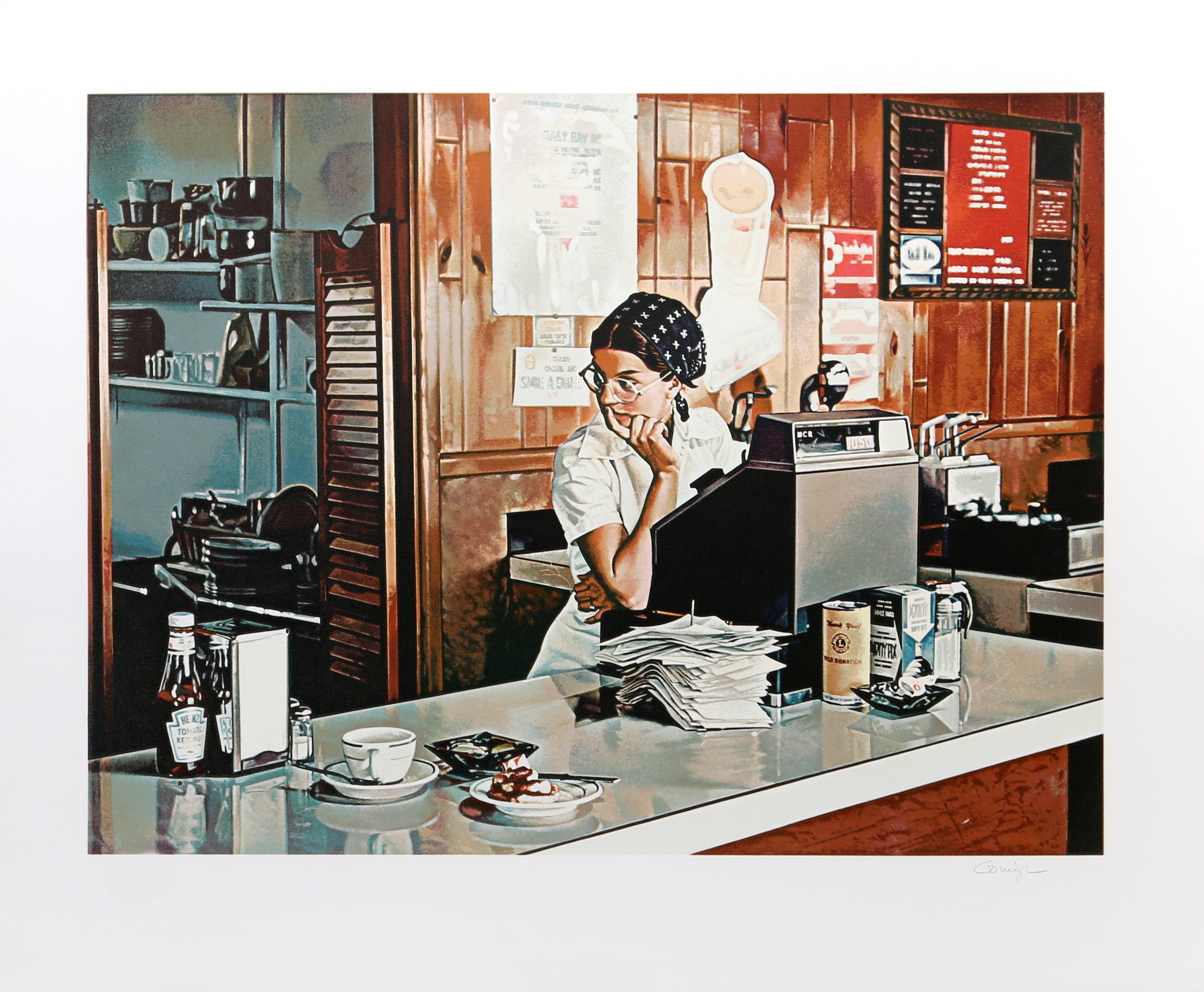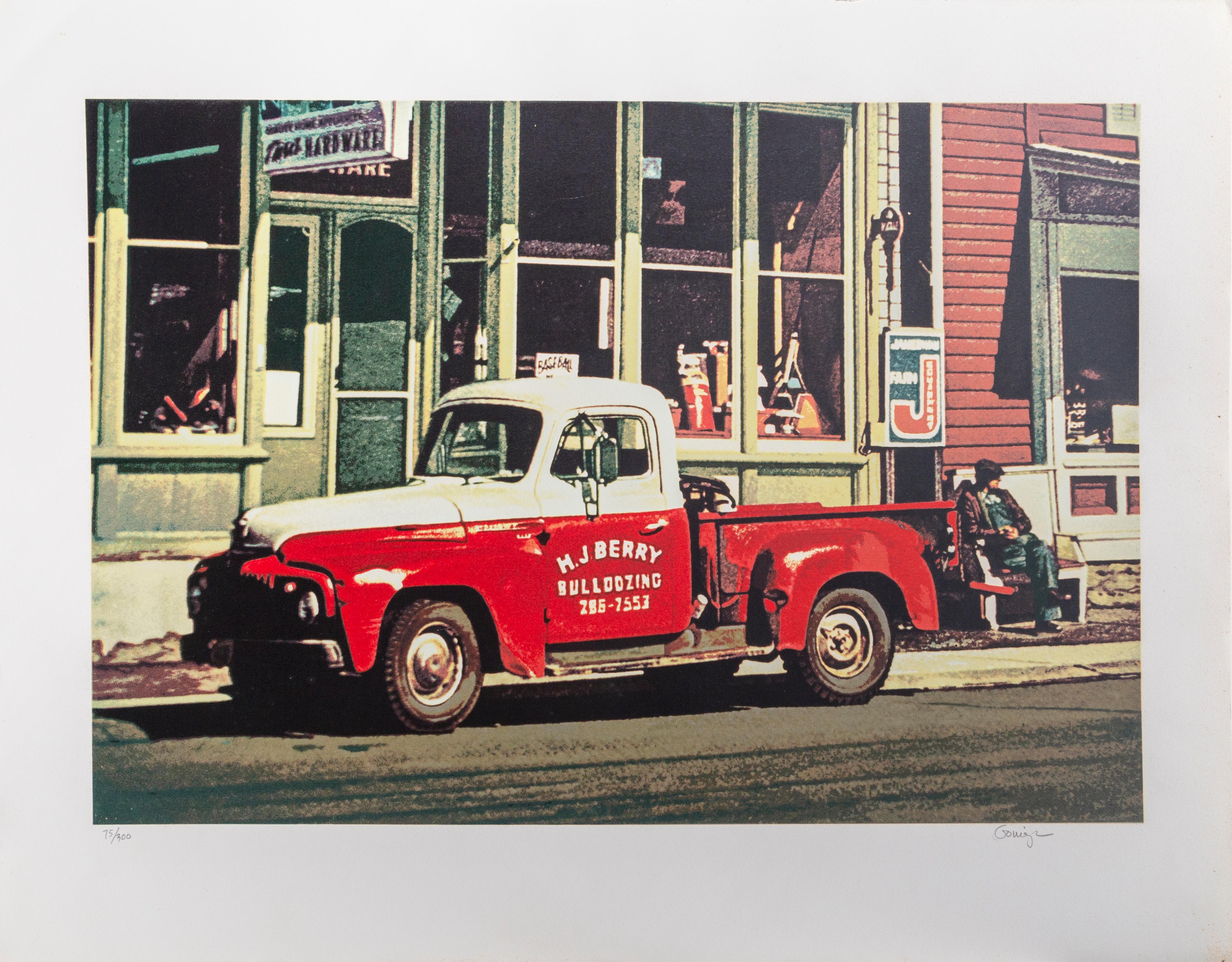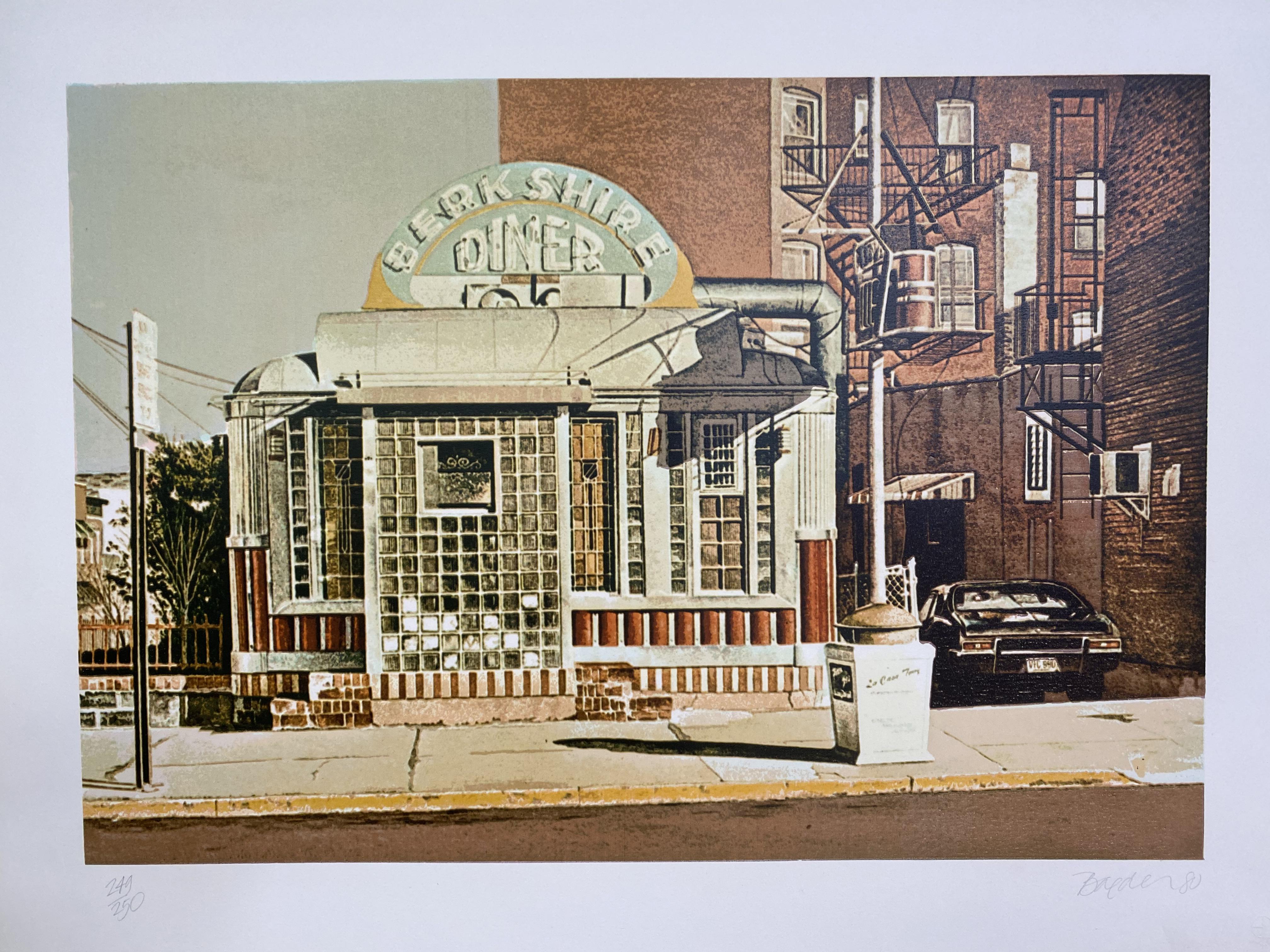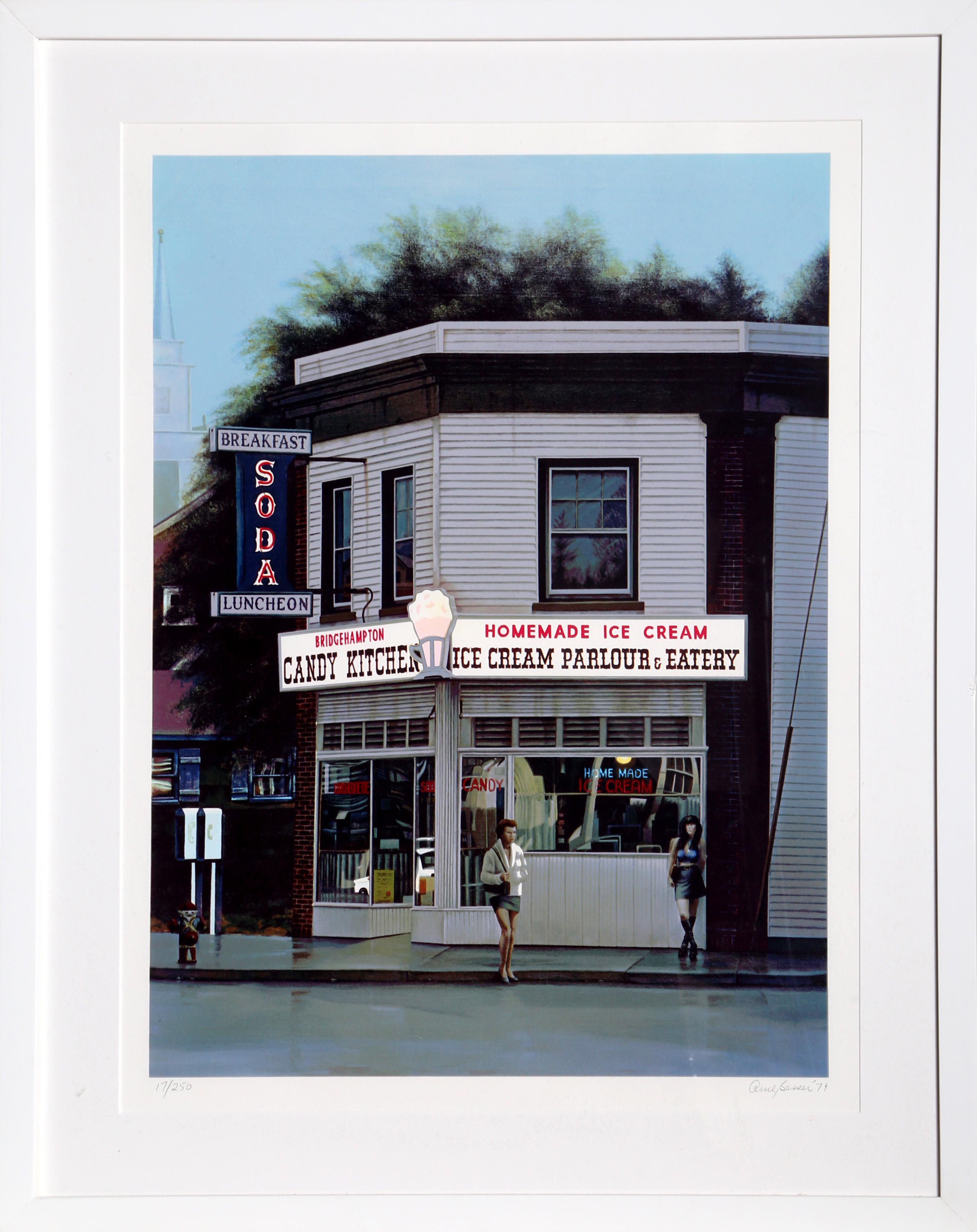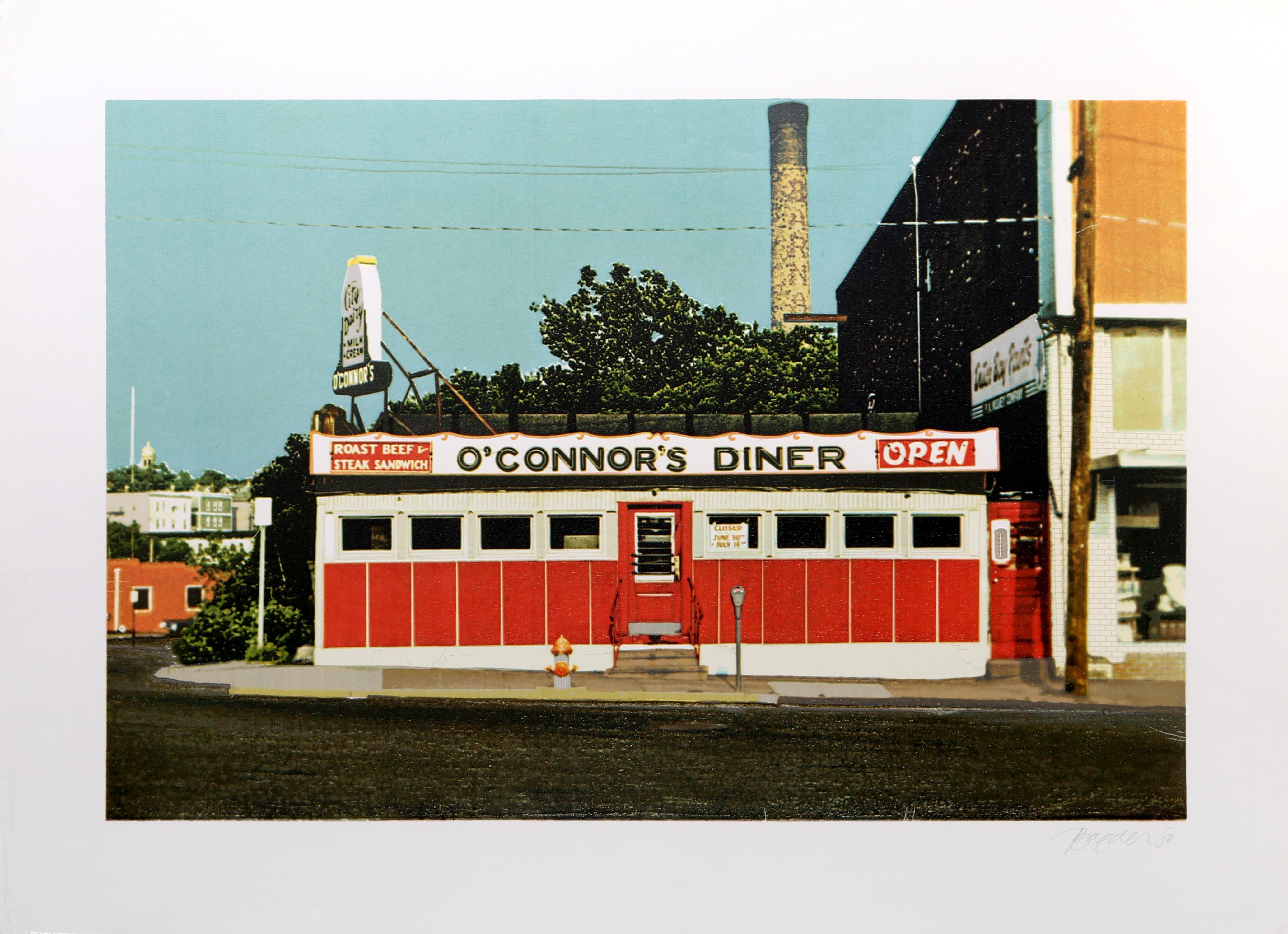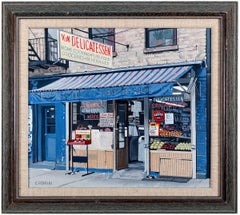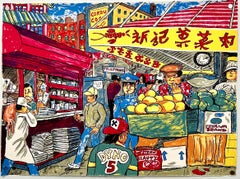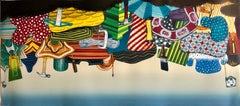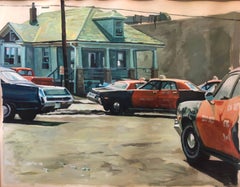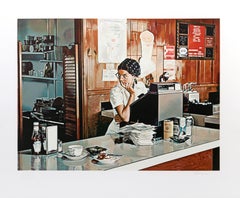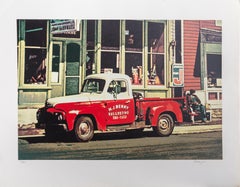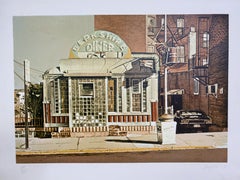Items Similar to Blimpie, America's Best Dressed Sandwich Pop Art Photo Realist Silkscreen Litho
Want more images or videos?
Request additional images or videos from the seller
1 of 13
Charles FordBlimpie, America's Best Dressed Sandwich Pop Art Photo Realist Silkscreen Litho1989
1989
$650
£491.95
€564.86
CA$925.98
A$1,004.25
CHF 527.47
MX$12,198.34
NOK 6,600.43
SEK 6,214.67
DKK 4,217.04
About the Item
Charles Ford, American Photo Realist Pop Artist Texas Artist
Photorealism is a movement which began in the late 1960's, in which scenes are painted in a style closely resembling photographs. The subject matter is usually mundane and without particular interest; the true subject of a photorealist work is the way we unconsciously interpret photographs and paintings in order to create a mental image of the object represented.
The leading members of the Photorealist movement are Richard Estes, Chuck Close, John Kacere,Ralph Goings and Robert Cottingham. Estes specializes in street scenes with elaborate reflections in window-glass; Close does enormous portraits of neutral faces. Other photorealists also typically specialize in a particular subject matter: trucks, horses, diners, etc.
B O R N
1941, Dallas, TX
E D U C A T I O N
1964 B.S. Degree in Mechanical Engineering at Lamar University, Beaumont, TX
E X H I B I T I O N S
Uptown Gallery, One-Man Show, New York City
Michele Birnbaum Fine Art, New York City
Museum of the City of New York, Permanent Collection
Rosenbaum Fine Art, Fort Lauderdale, Florida
Mallet Fine Art, New York City
Chicago Art Exposition, Chicago, Illinois
Love Galleries, Chicago, Illinois
Gallery Henoch, New York City
Las Vegas Museum of Contemporary Art,
Art Expo, New York City
Museum of the Hudson Highlands, Cornwall, New York,
Museum of the City of New York, "Painting New York"
Uptown Gallery, New York City
New Artists at Madison Square Garden, New York City
- Creator:Charles Ford (1941, American)
- Creation Year:1989
- Dimensions:Height: 21.9 in (55.63 cm)Width: 25.6 in (65.03 cm)
- Medium:
- Movement & Style:
- Period:
- Condition:
- Gallery Location:Surfside, FL
- Reference Number:1stDibs: LU38215047372
About the Seller
4.9
Platinum Seller
Premium sellers with a 4.7+ rating and 24-hour response times
Established in 1995
1stDibs seller since 2014
1,815 sales on 1stDibs
Typical response time: 1 hour
- ShippingRetrieving quote...Shipping from: Surfside, FL
- Return Policy
Authenticity Guarantee
In the unlikely event there’s an issue with an item’s authenticity, contact us within 1 year for a full refund. DetailsMoney-Back Guarantee
If your item is not as described, is damaged in transit, or does not arrive, contact us within 7 days for a full refund. Details24-Hour Cancellation
You have a 24-hour grace period in which to reconsider your purchase, with no questions asked.Vetted Professional Sellers
Our world-class sellers must adhere to strict standards for service and quality, maintaining the integrity of our listings.Price-Match Guarantee
If you find that a seller listed the same item for a lower price elsewhere, we’ll match it.Trusted Global Delivery
Our best-in-class carrier network provides specialized shipping options worldwide, including custom delivery.More From This Seller
View AllV and M Delicatessen
By Charles Ford
Located in Surfside, FL
Charles Ford's work is in the permanent collection of the Museum of the City of New York. Another wonderful painting by Charles Ford that shows the great lighting and shadows of New ...
Category
20th Century Photorealist Figurative Paintings
Materials
Oil
Red Grooms Canal St Chinatown Manhattan New York City Lithograph Cartoon Pop Art
By Red Grooms
Located in Surfside, FL
Red Grooms (American, b. 1937).
Lithograph in colors on wove paper, 1993
"East of Canal Street, Corner of Canal."
Published by the Brooklyn Museum
(Reference: Red Grooms: The Graphic Work, Walter G. Knestrick. Harry Abrams Inc Publishers, New York, 2001. Cat. no 138 page 172,
Alexander & Cowles 138).
Downtown Manhattan, New York City Chinatown Street scene with various vendors.
Hand signed in black crayon and numbered on image at bottom edge.
"8/115 Red Grooms."
Dimensions 22" x 30"
Printer: Sharks Lithographs Ltd, Boulder, CO
Red Grooms (born Charles Rogers Grooms on June 7, 1937) is an American multimedia artist best known for his colorful pop-art constructions depicting frenetic scenes of modern urban life. Grooms was given the nickname "Red" by Dominic Falcone (of Provincetown's Sun Gallery) when he was starting out as a dishwasher at a restaurant in Provincetown and was studying with Hans Hofmann.
Grooms was born in Nashville, Tennessee during the middle of the Great Depression. Red Grooms came of age in the shadow of the Abstract Expressionists. He studied at the Art Institute of Chicago, then at Nashville's Peabody College. In 1956, Grooms moved to New York City, to enroll at the New School for Social Research. A year later, Grooms attended a summer session at the Hans Hofmann School of Fine Arts in Provincetown, Massachusetts. There he met experimental animation pioneer Yvonne Andersen, with whom he collaborated on several short films. Grooms follows in the tradition of William Hogarth and Honoré Daumier, who were canny commentators on the human condition. In 1969, Peter Schjeldahl compared Grooms to Marcel Duchamp, because both embodied "a movement of one man that is open to everybody."
In the spring of 1958, Grooms, Yvonne Andersen and Lester Johnson each painted twelve-foot by twelve-foot panels, which they erected with telephone poles on a parking lot adjacent an amusement park in Salisbury, MA. Inspired by artist-run spaces such as New York's Hansa Gallery and Phoenix, and Provincetown's Sun Gallery, Grooms and painter Jay Milder opened the City Gallery in Grooms' second-floor loft in the Flatiron District. When Phoenix refused to show Claes Oldenburg, Grooms and Milder dropped out of Phoenix and City Gallery presented Oldenberg's first New York exhibition, as well as that of Jim Dine. Other artists who showed at City Gallery include Stephen Durkee, Mimi Gross (daughter of Chaim Gross and Red Grooms wife), Bob Thompson, Lester Johnson, and Alex Katz. Grooms never developed the detached stance of such Pop Art practitioners as Andy Warhol, Roy Lichtenstein or James Rosenquist. Instead he painted his own life, and became, literally, an actor on the stage of life -- in this case the art-as-life "happenings" of the downtown New York scene. Inspired by George Méliès's 1902 film A Trip to the Moon...
Category
1990s Pop Art Figurative Paintings
Materials
Lithograph
Color Lithograph Linocut Chine Collé "Workshop" Bright Modernist Pop Art
By Tom Burckhardt
Located in Surfside, FL
Hand signed and numbered edition of 25. 16 x 36" sheet size without frame.
“Workshop” is an ambitious color lithograph and linocut with chine collé printed in twelve colors from nine plates and one linocut. It has been printed in an edition of 25, plus proofs, on white Rives BFK paper 16 x 36” with chine collé of various papers. (No, it’s not upside down)
Born 1964 in New York where he still currently resides and works alongside his partner the ceramist Kathy Butterly. Son of the photographer Rudy Burckhardt and painter Yvonne Jacquette, Tom Burckhardt was 1986, BFA, State University of New York, Purchase, NY
1992–1993, Skowhegan School of Painting and Sculpture, ME
1996, Marie Walsh Sharpe Art Foundation Studio Grant
1997, New York Foundation for the Arts, Painting Grant
1997 Pollock-Krasner Foundation Grant
2002 George Hitchcock Award, National Academy of Arts
2003, Richard & Hinda Rosenthal Foundation Award, American Academy
2005, AICA Best Show of an Emerging or Underknown Artist
2005 Pollock-Krasner Foundation Grant
2006 Best Installation, Best of Houston, the Houston Press
2009 Guggenheim Foundation Grant
2010, New York Foundation for the Arts Drawing/Print Grant
2010 Joan Mitchell Foundation Grant
Tom Burckhardt’s work is a carnival of images jumbled and jostling each other in precarious nonsensical compositions. He uses lushly colored and patterned images from all kinds of sources that bounce between abstraction and representation. Images come from tool catalogs, paper and fabric patterns, funhouse painting, architectural details, stripes, dots and squiggles. It is as if Burckhardt is a cartoonist merrily channeling Ellsworth Kelly, Paul Feeley, Robert Therrien, and Myron Stout, among others. Like Red Grooms, for whom he worked as an assistant, Burckhardt ransacks his influences yet ends up with something unmistakably his own. His work bears the influence of is a synthesis of many things: the tribal-influenced abstract painting of Steve Wheeler...
Category
Early 2000s Pop Art Interior Prints
Materials
Lithograph, Linocut
1980s Vintage American Street Scene Painting, Landscape with Taxi Cabs
By Val Lewton
Located in Surfside, FL
Val Edwin Lewton (May 23, 1937 – April 24, 2015) was a painter and museum exhibition designer. As an artist, he created Realist acrylic paintings and watercolors of urban and suburban scenes, predominantly in the Washington, D.C., area, where he lived and exhibited.
Val Lewton was born May 23, 1937, in Santa Monica, California. His father, also named Val Lewton, produced a string of successful and influential B movies for RKO Pictures, including Cat People (1942) and I Walked with a Zombie (1943). His mother, Ruth Knapp, was a painter and teacher of autistic children.
He graduated in 1959 from Whitman College in Walla Walla, Washington, and earned a master's degree in fine arts from Claremont University in 1962. After moving to Washington, D.C., he served on the staff of the Smithsonian American Art Museum for 32 years, simultaneously maintaining a career as a painter in his own right.
Lewton died in 2015s oon afterwards, exhibitions of his paintings were planned for the Katzen Arts Center (June 17 – August 13, 2017) and Addison/Ripley Fine Art (June 3 – July 8, 2017).
Chiefly known for his landscapes, Lewton generally depicted cities and suburbs with a detached, impersonal sensibility. Writing about his watercolors in Arts magazine in 1980, Harry Rand observed, “Either by implication or statement, personalities are absent from Lewton’s work; there is hardly a sense of the lives that move through those spaces he describes.” The critic compared the artist to Fairfield Porter, Edward Hopper, and Charles Sheeler.
Lewton painted from a young age. On a family trip to the Museum of Modern Art in New York City, he discovered the work of Henri Matisse, an encounter that permanently influenced his artistic vision. In the early 1960s, Lewton lived in southern California and taught art classes at the University of California Riverside. During this period, he was inspired by the paintings of Roger Kuntz...
Category
1980s Photorealist Landscape Paintings
Materials
Acrylic, Archival Paper
Large Silkscreen Serigraph of A House in Dunes, Americana Folk Art
By Ted Jeremenko
Located in Surfside, FL
Serigraph Silkscreen on Arches paper, hand signed and numbered in pencil.
Theodore Jeremenko was born in Yugoslavia in 1938. When he was twelve, Ted and his family moved to the Un...
Category
1980s Folk Art Landscape Prints
Materials
Canvas, Acrylic
Still Life with Hans Maler Pop Art Serigraph Hand Signed
By Josef Levi
Located in Surfside, FL
On deckle edged watermarked Arches French paper. hand signed in pencil, dated and numbered. the edition size is 175.
there are three states of the same image image each with increasing detail and color. This is just for the one in the photo.
Josef Alan Levi (1938) is an American artist whose works range over a number of different styles, but which are unified by certain themes consistently present among them. Josef Levi began his artistic career in the 1960s and early '70s, producing highly abstract and very modernist pieces: these employing exotic materials such as light fixtures and metallic parts. By 1975, Levy had transitioned to painting and drawing still lifes. At first these were, traditionally, of mundane subjects. Later, he would depict images from art history, including figures originally created by the Old Masters. Around 1980, he made another important shift, this time toward creating highly precise, though subtly altered reproductions of pairs of female faces which were originally produced by other artists. It is perhaps this work for which he is most well known. Since around 2000, Josef Levi has changed the style of his work yet again: now he works entirely with computers, using digital techniques to abstract greatly from art history, and also from other sources.
Levi's works of art in the collections of the Museum of Modern Art, NYC, the National Gallery of Art, and the Albright-Knox Museum, among many others. Levi's art has been featured on the cover of Harper's Magazine twice, once in June 1987, and once in May 1997.
Josef Levi received a Bachelor of Arts degree in 1959 from the University of Connecticut, where he majored in fine arts and minored in literature. From 1959 to 1960, he served to a first lieutenant in the U.S. Army, and from 1960 through 1967 he was in the U.S. Army Reserves.
In 1966, he received the Purchase Award from the University of Illinois in 1966, and he was featured in New Talent U.S.A. by Art in America. He was an artist in residence at Appalachian State University in 1969, taught at Farleigh Dickenson University in 1971 and was a visiting professor of art at Pennsylvania State University in 1977. From 1975 to 2007, Levi resided in New York City. He now lives in an apartment in Rome, where he is able to paint with natural light as he was unable in New York.
From 1959 to 1960, Josef took some courses of Howard McParlin Davis and Meyer Schapiro at Columbia University which initiated him into the techniques of reproducing the works of the Old Masters. His first works, created in the 1960s, were wood and stone sculptures of women. His first mature works were abstract pieces, constructed of electric lights and steel.
In 1970, Levi's materials included fluorescent light bulbs, Rust-Oleum and perforated metal in addition to paint and canvas.
By 1980, Josef Levi's art had transformed into a very specific form: a combination of reproductions of female faces which were originally depicted by other artists. The faces which he reproduces may be derived from either portraits or from small portions of much larger works; they are taken from paintings of the Old Masters, Japanese ukiyo-e, and 20th-century art. Artists from whom he has borrowed include: Vermeer, Rembrandt, Piero della Francesca, Botero, Matisse, Utamaro, Correggio, Da Vinci, Picasso, Chuck Close, Max Beckmann, Pisanello, Lichtenstein. The creation of these works is informed by Levi's knowledge and study of art history.
Josef Levi's paintings from this period are drawn, then painted on fine linen canvas on wooden stretchers. The canvas is coated with twenty-five layers of gesso in order to produce a smooth surface on which to work. The drawing phase takes at least one month. Levi seals the drawing with acrylic varnish, and then he may apply layers of transparent acrylic in order to approximate the look of old paintings. After the last paint is applied, another layer of acrylic varnish is sprayed on to protect the work.
Most of the figures in his contemporary pieces are not paired with any others.
SELECTED COLLECTIONS
MUSEUM OF MODERN ART, NEW YORK, NY
ALBRIGHT- KNOX GALLERY, BUFFALO, NY
ALDRICH MUSEUM OF CONTEMPORARY ART, RIDGEFIELD, CT
NATIONAL GALLERY OF ART, WASHINGTON, DC
BROOKLYN MUSEUM OF ART, BROOKLYN, NY
SMITHSONIAN NATIONAL MUSEUM OF AMERICAN HISTORY, WASHINGTON, DC
CORCORAN GALLERY, WASHINGTON, DC
UNIVERSITY OF NOTRE DAME ART...
Category
1970s Pop Art Figurative Prints
Materials
Lithograph, Screen
You May Also Like
One-Eleven Diner, Photorealist Screenprint by Ralph Goings
By Ralph Goings
Located in Long Island City, NY
In this photorealistic print, Ralph Goings focuses on the classic American diner with his depiction of a lone waitress behind the counter. With h...
Category
1980s Photorealist Still-life Prints
Materials
Screen
Bulldozing International, Photorealist Lithograph by Ralph Goings
By Ralph Goings
Located in Long Island City, NY
Artist: Ralph Goings, American (1928 - 2016)
Title: Bulldozing International
Year: 1981
Medium: Lithograph, signed and numbered in pencil
Edition: 300; 40 AP's
Image Size: 17 x 24 i...
Category
1980s Photorealist Still-life Prints
Materials
Lithograph
Berkshire Diner - 1980 Signed Limited Edition Screenprint
By John Baeder
Located in Rochester Hills, MI
John Baeder
Berkshire Diner - 1980
Print - Serigraph on Somerset paper
Paper Size - 30'' x 22'' in.
Edition: Signed in pencil and marked from the edition of 250
John Baeder's calcula...
Category
1980s Photorealist Landscape Prints
Materials
Screen
Twin Springs Diner, Photorealist Screenprint by Ralph Goings
By Ralph Goings
Located in Long Island City, NY
Featuring two men seated at the counter of a diner, Ralph Goings’s depiction of a classic American establishment can be viewed as a prime example of photorealism. Although both figur...
Category
1980s Photorealist Still-life Prints
Materials
Screen
Bridgehampton, Photorealist Screenprint by Arne Besser
Located in Long Island City, NY
Bridgehampton by Arne Besser, American (1935–2012)
Portfolio: Cityscapes
Date: 1981
Screenprint, Signed and numbered in pencil
Edition of 250, 30 AP
Size: 30 in. x 22 in. (76.2 cm x ...
Category
1980s Photorealist Landscape Prints
Materials
Screen
O'Connor's Diner, Photorealist Silkscreen by John Baeder
By John Baeder
Located in Long Island City, NY
Artist: John Baeder, American (1938 - )
Title: O’Connor’s Diner
Year: 1980
Medium: Screenprint, signed and numbered in pencil
Edition: 250
Size: 22 x 30 in. (55.88 x 76.2 cm)
Category
1980s Photorealist Landscape Prints
Materials
Screen
More Ways To Browse
Jean-Baptiste-Camille Corot On Sale
Jim Buckels On Sale
John Hall Thorpe
John Sloane
Kubo Shunman
Luigi Kasimir Fleet Street
Magritte Empire Of Light
Marianne Almasy
Michael Graves Print
Nancy Wilds
Nell Revel Smith
Paolo Boni
Pedro Lemos
Peter Max Quiet Lake
Phillip Sage
Prince Charles Signed Lithographs
Provincetown Woodcuts
Retro Aspen Ski Posters
